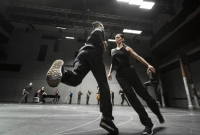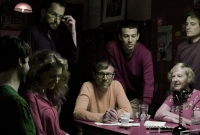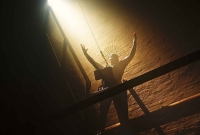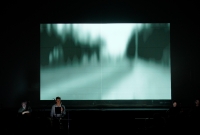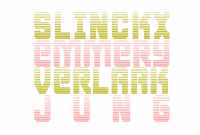Anne Teresa De Keersmaeker's exploration of Grisey's spectralism is an astonishing triumph.
by Maxim Boon on January 16, 2016
Classical Music | Chamber | Dance | Comment Now
★★★★★
In 1982 at the age of 22, Anna Teresa De Keersmaeker was hailed as a visionary for her forensically detailed exploration of the minimalism of Steve Reich, Fase, and this breakthrough piece launched her career with meteoric fervour. Over three decades later, now firmly cemented as one of the world’s most respected (and intransigent) dance makers, the Belgian choreographer’s muse remains music, investigated with a level of probing, exhaustive focus that borders on the superhuman.

Vortex Temporum, created by De Keersmaeker in 2013, is an uncompromising setting of the music of French spectralist Gérard Grisey, but to say this is merely a choreographic response to the score would be a tremendous understatement. De Keersmaeker’s grasp of this piece is microscopic in its analysis. The density and interaction of the timbres, the nuance and eccentricity of the tempi, the breadth and flow of the harmony: there isn’t a single facet of this extraordinary soundworld that falls outside of her understanding. But this also offers a challenge for the audience. De Keersmaeker is single-minded in her task – nothing less than the most absolute distillation of her source material is acceptable. This not only means the demands on her dancers and musicians are staggering; the viewer must also keep pace with her relentless intelligence.
Belgian contemporary music ensemble Ictus are the sole occupants of the bare stage for the work's opening section. Performing from memory, their communication of Grisey’s turbulent music is unhindered by music stands, and thus the urgency of the score strikes with compelling immediacy. An insistent succession of shrill, undulating woodwind arpeggios cuts through the air and recedes like a dying echo in the cavernous space of Carriageworks’ Bay 17. The strings follow with a tense chorale of asymmetric rhythms and pendulous intervals, before pianist Jean-Luc Plouvier rips through the texture with a furious cadenza of rippling, insectoid quarter-tones punctuated with thunderous clusters. The rest of the ensemble depart the stage, chased away by the brut-force of this solo, before Plouvier, with one final emphatic attack, abruptly leaps up and exits.
After this exclusively auditory start, De Keersmaeker introduces her dancers, who enter with an informal nonchalance. They take up their marks in the same space the musicians had occupied, and in silence commence a complex unfolding of movements. Initially the impetus of this display feels elusive, although it seems as if there could be an underlying logic to this interplay of sweeping arms and fluid lines fractured by suddenly explosive leaps.
Certain gestures are repeated, sometimes in unison, but more often with a staggered phrasing that weaves its way through the group with a serpentine finesse. With just the occasional squeak of a rubber sole against the ground and the rhythmic panting of their breaths, this construction of pure, abstracted dance dissipates as all but one dancer is left on stage. Delivering a furious and elaborate solo of jagged leaps and rapid, flat-footed shuffles, there appears to be no intelligible sense to the choreography – until, at last, the music and movement are united.
As Plouvier once again takes up the muscular piano solo, a veil is lifted and we see how inseparably fused the music and dance really is: each pivoting turn and crooked twisting step now corresponds to a specific musical attack. It’s a moment of breath-taking revelation as we suddenly understand how meticulous De Keersmaeker’s interrogation of the score has been, a silent but precisely traced geometry of the music in three-dimensional space.
As the relationship between sound and movement is revealed, her strategy changes as the music enters a nebulous cloud of warping chords that slowly smear and crumble. Now the musicians as well as the dancers are itinerant, tracing huge orbits of concentric circles across the stage. Even the piano is pulled into this swirling vortex, wheeled around the space whilst still being played. Clusters of individuals aggregate before being flung outward as if caught in some gravitational field. The effect is striking, allowing the ever changing physical relationships of the dancers and musicians to constantly transform our perception of the space. The harsh fluorescent lighting also adopts this sweeping momentum, tracking the piano as it travels in its arc across the stage. Dancers and musicians become silhouetted against this one shifting source of illumination, before disappearing once more into the inky darkness. It’s a surprisingly theatrical statement - there is an impression of cosmic vastness that is simultaneously evocative of the subatomic; a universe in a grain of sand.
This is without a doubt a work of vast intelligence, but more than this – Vortex Temproum is extraordinarily and profoundly beautiful, and it’s this duality that makes this piece truly remarkable. De Keersmaeker’s intention is to rigorously decode the spectral genius of Grisey, and she is deliberately unsentimental about achieving this. Yet there is also a clear desire to communicate how affecting this score has been on her, and so there is a subtle but consistent undercurrent of dramatic tension throughout. This is all the more astonishing when you consider the technical and mental demands this piece makes on its performers. Grisey’s music is incredibly detailed and this complexity is inevitably echoed in the intricacy of the choreography. Nothing less than the total, unwavering concentration of the entire cast of dancers and musicians is required to realise this work, but the results are powerful. Rarely does beauty and intellect combine in such a persuasive and arresting way.
Rosas and Ictus present Vortex Temporum, at the Sydney Festival until January 18.
